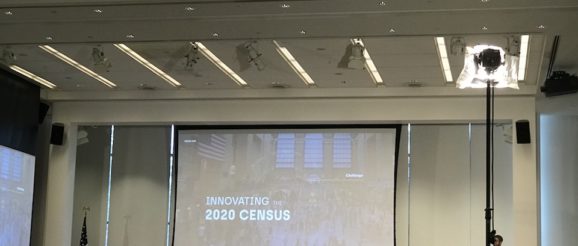U.S. Census Bureau Rolls Out Innovation Tools for 2020 Count


With next year’s first-ever heavily digital U.S. Census fast approaching, the Census Bureau has now rolled out a series of new projects, tools and collaborative programs aimed at helping to ensure an accurate count of residents.
The Census Bureau held a Demo Day for these new initiatives Dec. 10 at its headquarters just outside of Washington, D.C. The assets unveiled there were wide-ranging, and, perhaps most importantly for communities, many of them were designed to bolster work already being done to support the Census by stakeholders at the local level.
One of the most noteworthy segments of the day was from a Census Bureau-led campaign called Census Accelerate, which has a mission of helping community-based organizations create innovative content that can reach hard-to-count communities during the Census. One of the ways Census Accelerate is doing this is through a new initiative called Creatives For the Count, which brings together the aforementioned community organizations with creatives, including designers, copywriters and influencers.
The idea is that the community groups have a great desire to reach people who might not otherwise fill out the Census, but they do not necessarily have the creative skills to craft effective messaging. So, the program seeks to match them with those who do, said Census Accelerate Director Mara Abrams.
To this end, there have so far been 15 Creatives For the Count events held across the country, in a wide range of diverse cities, including Los Angeles; Portland, Ore.; Washington, D.C.; and El Paso, Texas. In addition, Census Accelerate built a toolkit that can help communities host their own create-a-thon events. To supplement all of this, there is also a new website — — which is a content repository where people can share successful Census outreach strategies and advice with each other. They can also put in requests for others to create the content that they need to push their work further.
“We’re building a movement to get out the count,” Abrams said, “and we’ve created a number of tools to scale this movement throughout the country.”
Another noteworthy segment at the Demo Day event was the launch of Opportunity.Census.Gov/data, which was timed to coincide with it. That site is essentially a data hub designed to be useful for anyone seeking to solve problems with issue-specific data, both during and after the Census. Like the Creatives For the Count initiative, this data hub relies on human expertise, this time doing so via a series of recommendations from government experts about useful data. At present, the hub mostly consists of data sets designed to solve workforce challenges, but there are plans to add other themes soon, like geospatial data.
“Users crave a waypoint,” said Ivan Metzger, strategic advisor and head of design for the Census Open Innovation Labs group, during a presentation about the data hub. “They crave guidance from the people who know the data best.”
The Census Bureau itself is not the only entity building tools to help support next year’s count. In fact, some of the projects on display during the recent Demo Day event were built by third-party companies and organizations. These ranged in nature from a digital toolkit aimed at helping community groups spread stories among diaspora populations about why the Census matters, to a platform that enables testing messaging among hard to count Census populations.
The reason so much effort is going into this work is that there is a lot at stake — funding, political representation, the accuracy of mass amounts of data — and experts say the Census being primarily digital creates new challenges for many on the other side of the nation’s acute digital divide. At the same time, though, the Census Bureau and organizations that support it have built this host of new tools to help.
And while there are major reasons for concern related to the count — ranging from the looming threat of misinformation campaigns to a reduction in funding relative to previous years — this being the first mostly-digital Census does create some new opportunities for innovation. To this end, the Census Bureau has been working to foster internal culture change, offering a human-centric design training project that is currently focused on teaching the discipline to management and supervisors in the organization.
And this institutional support for innovation is not just talk.
Near one of the main entrances of the U.S. Census Bureau, there is a primo parking spot with a bright red sign labeling it as reserved for the “Innovator of the Month.”
This is a nice incentive, aimed at rewarding employees who buy into what’s being taught and devise new and better ways for the federal agency to conduct its arduous decennial count of every single person in the U.S. It’s rare to find such a great parking spot rewarded to an innovator outside monolithic governmental fortresses like the one occupied by the Census Bureau near Washington, D.C., but from a certain perspective, it’s a physical manifestation of a sea change within the Bureau to emphasize the importance of new ideas in the face of such a massive challenge.
